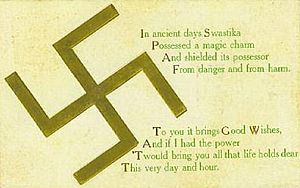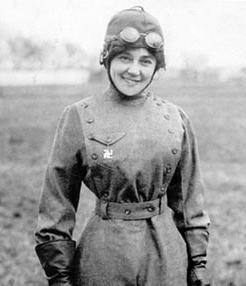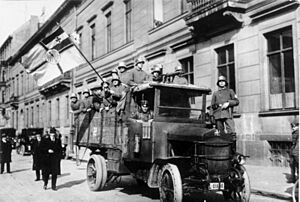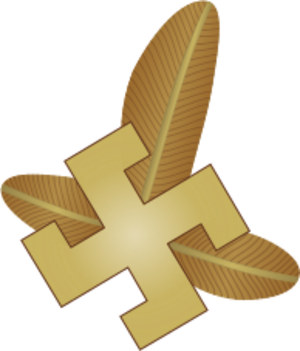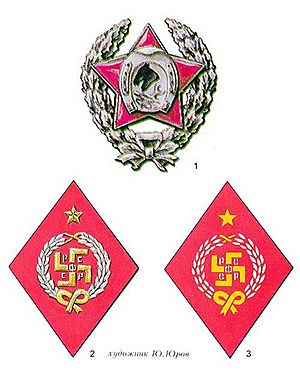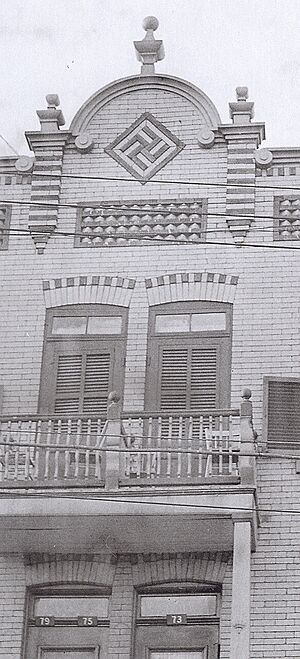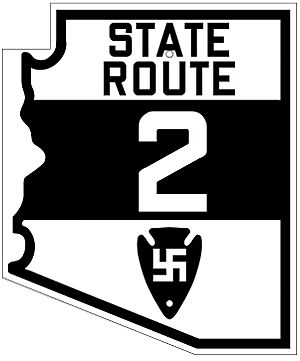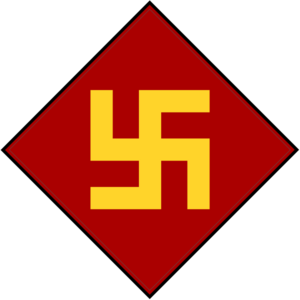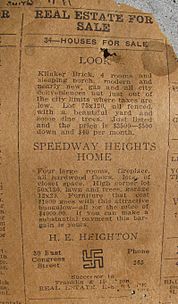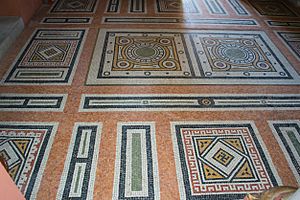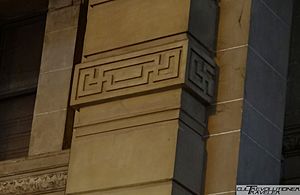Western use of the swastika in the early 20th century facts for kids
The swastika is a very old and important symbol that comes from a language called Sanskrit. It looks like a cross with four arms, each bent at a 90-degree angle. Sometimes the arms point to the right (卐) and sometimes to the left (卍). This symbol has been used for at least 11,000 years!
For many cultures in Eurasia, especially in Hinduism, Buddhism, and Jainism, the swastika is a sacred sign. It often means good luck, peace, or well-being. In the early 1900s, it even became a popular good luck charm in Western countries. However, in the 1920s, the Nazi Party in Germany started using the swastika as their main symbol. Because of this, the swastika became linked to their terrible actions during World War II. After the war, many people in Western countries stopped using the swastika, and some old swastika symbols were even removed or covered up.
The Swastika's Long History
Long ago, people discovered that many languages in Europe and Asia were connected. This led archaeologists to look for links between ancient European people and groups like the "Aryans." When Heinrich Schliemann found swastika symbols in the ancient city of Troy, he thought it was a special symbol for these early groups. He believed it connected cultures from Germany, Greece, and India.
By the early 1900s, the swastika was known all over the world as a sign of good luck. The Smithsonian even wrote a book about its global use in 1894. You could find the swastika in many everyday designs, like on postcards, jewelry, and even company logos.
Sadly, this changed when the Nazi Party chose the swastika as their emblem. They used it to promote their ideas about a "pure" German race. After World War II, most people in the Western world only knew the swastika as a Nazi symbol. This caused a lot of confusion about its much older, peaceful meanings.
Swastikas Around Europe
Denmark
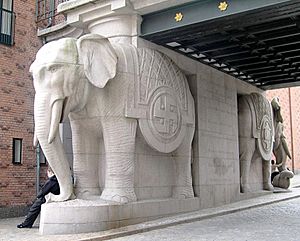
The Danish company Carlsberg Brewery used the swastika as its logo for many years, starting in the 1800s. They stopped using it in the mid-1930s because of its connection to the Nazi Party. However, if you visit their headquarters in Copenhagen, you can still see swastikas carved on the elephant statues at the entrance, put there in 1901.
Finland
In Finland, the hakaristi (swastika) was used by the Finnish Defence Forces and the Finnish Air Force from 1918 to 1945. It was also seen in other groups. Finnish traditions often use a "hook-cross" design.
Even today, some Finnish Air Force units still have a swastika on their flags. The Air Force Academy's flag, for example, has three swastikas. In 2017, the Air Force Command changed its main emblem, but the symbol remains on some flags and medals.
Germany
Before the Nazis became powerful, some nationalist groups in Germany also used the swastika. For example, photos from the 1920 Kapp Putsch show a group called the Marinebrigade Ehrhardt using the symbol.
Ireland
In Dublin, Ireland, a laundry company called the Swastika Laundry used a swastika logo from 1888. Even during World War II, they kept the name, adding "1912" (their founding year) to show they used the symbol first. Their delivery vans were red with a black swastika. The company's tall chimney also had a large white swastika, which was a protected structure. The name and logo eventually disappeared when the laundry joined another company.
Poland
The swastika, known as swarzyca, was common in Slavic lands since the Middle Ages. It was linked to the god Svarog. Later, it became a personal symbol for some people and was used in folk art, especially in the Podhale region. There, it was painted on houses in the Tatra Mountains as a talisman to protect the home.
Polish mountain infantry units adopted this ancient symbol in the 1920s. It was used as a special sign for some army divisions. The swastika also appeared in other Polish symbols, like the logo of a publishing company and the personal symbol of composer Mieczysław Karłowicz.
Russia
The last Russian Empress, Alexandra Feodorovna, liked the left-facing swastika and drew it for good luck. In 1917, the Russian government even printed new bank notes with swastikas. During the Russian Civil War, some Red Army units also wore armbands with the swastika.
However, in 1922, a Soviet official warned against using the swastika. He said it had become a symbol of a "deeply negative" movement, meaning fascism.
Swastikas in North America
Canada
There's a small town in Ontario, Canada, called Swastika. It was founded in 1906. During World War II, the government tried to change its name, but the town refused! Many people put up signs saying, "The hell with Hitler. We came up with our name first!" The town still has a Swastika United Church and Swastika Public School.
Other places in Canada also used the symbol. There were even ice hockey teams called the "Windsor Swastikas" and "Fernie Swastikas" in the early 1900s.
United States
Native American Symbolism
For many Native American tribes, like the Navajo, Apache, and Hopi, the swastika was a very important symbol of friendship and good luck. The Arizona Department of Transportation even used a swastika on its state highway signs until 1942, when the U.S. entered World War II.
After the war began, several Native American tribes decided to stop using the swastika in their art. They said that the symbol, which had meant friendship for centuries, had been "desecrated" by another nation.
Military Use
The 45th Infantry Division of the United States Army used a yellow swastika on a red background as their unit symbol until the 1930s. They wore this patch while fighting in World War I.
The Lafayette Escadrille, a squadron of American pilots who fought for France in World War I, had a Native American figure with a swastika on their official insignia.
Government and Public Buildings
Many government buildings in the U.S. built before World War II feature swastikas as decorative elements. For example, the Marriner S. Eccles Federal Reserve Board Building in Washington D.C., completed in 1937, has swastikas around its exterior windows.
The Reno, Nevada Post Office, designed in 1932, includes swastikas. The Allentown, Pennsylvania Post Office, built in 1934, had swastika floor tiles. Some were removed in 1965, but others remained.
Commercial Use
In the early 1900s, the swastika was used in many advertisements and products. Postcards wished people good luck with swastika designs. Even Coca-Cola made "lucky" brass watch fobs in the shape of a swastika in the 1920s.
Companies like the K-R-I-T Motor Car Company and the Buffum Tool Company used the swastika in their logos. Flour was sold under the brand name Swastika, meaning "The Lucky Flour." There were even "Swastika Theaters" and a "Swastika Novelty Company."
Architectural Decorations
You can find swastikas in the architecture of many old buildings across the U.S. The James A. Garfield Memorial in Cleveland Ohio, built in 1890, has swastika tile patterns on its floor. The Yale University Library has a small swastika in its carvings.
In Chicago, many buildings from before World War II have swastikas in their designs, including Navy Pier and the University of Chicago. The Montana Club in Helena, Montana, rebuilt in 1905, has a swastika design on its entryway floor, meant as a welcoming symbol.
Efforts to Remove Swastikas
Over time, as the swastika became strongly associated with the Nazis, there have been efforts to remove these historical symbols. In Glendale, California, more than 900 lampposts with swastikas from the 1920s remain. The city decided to keep them because they were installed before the Nazi association.
Some schools and churches have removed swastika tiles or designs after complaints. For example, in 2006, five terra cotta tiles with swastikas were removed from St. Mary's Cathedral in St. Cloud Minnesota. However, other places, like the Bonneville County Courthouse in Idaho Falls, Idaho, have chosen to keep them, explaining their original meaning.
Swastikas in Oceania
Australia
In Sydney, Australia, two important buildings, the Dymocks Building and the Customs House, have swastika tiles on their floors. These designs date back to the 1920s, before the Nazi Party used the symbol. Signs in the buildings explain that the symbol is a "fylfot" and was used much earlier.
During World War I, Australia's 3rd Division used the swastika as their group sign on vehicles and equipment.
Swastikas in South America
Argentina
In Buenos Aires, Argentina, the train station of Retiro, built in 1915, has columns decorated with swastikas.


